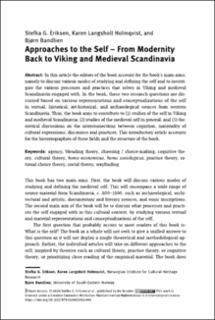| dc.contributor.author | Eriksen, Stefka Georgieva | |
| dc.contributor.author | Holmqvist, Karen Langsholt | |
| dc.contributor.author | Bandlien, Bjørn | |
| dc.date.accessioned | 2021-01-06T10:14:35Z | |
| dc.date.available | 2021-01-06T10:14:35Z | |
| dc.date.created | 2020-09-07T14:58:31Z | |
| dc.date.issued | 2020 | |
| dc.identifier.isbn | 9783110655551 | |
| dc.identifier.uri | https://hdl.handle.net/11250/2721671 | |
| dc.description.abstract | In this article, the editors summarize how the different starting points for studying the self in the articles of this book, lead to different conclusions with regard to the nature of the self and the distribution of agency: cultural / social / practice theorists give priority to the context, the discourse, the practice when defining the self, while cognitive theorists give agency to various human agents behind cultural expressions. Based on this synthesis of the articles’ approaches and results, the article, and the book as a whole, conclude that every given expression or conceptualization of the self is certainly conditioned by its specific historical and socio-cultural context. However, the emergence of the self in itself appears as a constant cognitive process of traveling and unfolding, wayfinding and choice-making, that happens continuously in all historical and social contexts and in all individuals, known and unknown. | |
| dc.language.iso | eng | en_US |
| dc.relation.ispartof | Approaches to the Medieval Self. Representations and Conceptualizations of the Self in the Textual and Material Culture of Western Scandinavia, c. 800–1500 | |
| dc.title | The Self in Viking and Medieval Scandinavia, and Beyond: Between the Material, Social and the Cognitive | en_US |
| dc.type | Chapter | en_US |
| dc.description.version | publishedVersion | |
| dc.source.pagenumber | 325-332 | en_US |
| dc.identifier.cristin | 1827861 | |
| dc.relation.project | Norges forskningsråd: 250560 | |
| cristin.ispublished | true | |
| cristin.fulltext | original | |
| cristin.qualitycode | 2 | |
